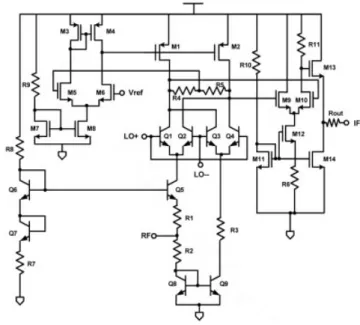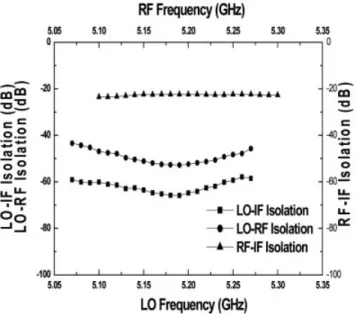6. W. Ng, R. Stephens, D. Persechini, and K. V. Reddy, Ultra-low jitter mode locking of Er-fibre laser at 10 GHz and its application in photonic sampling for analogue-to-digital conversion, Electron Lett 37 (2001), 113–115.
7. Y. Hu, M. Dubov, and I. Khrushchev, Spectrally-controlled, gain-switched operation of InGaN diode laser, Electron Lett 40 (2004), 702–703.
© 2006 Wiley Periodicals, Inc.
5.2 GHz HIGH ISOLATION SIGE
BICMOS CMFB GILBERT MIXER
Chinchun Meng,1Tzung-Han Wu,1Tse-Hung Wu,1and Guo-Wei Huang21Department of Communication Engineering, Chiao Tung University,
Hsinchu 300, Taiwan, Republic of China
2National Nano Device Laboratories, Hsinchu 300, Taiwan, Republic
of China
Received 5 July 2006
ABSTRACT: Active PMOS loads with common mode feedback to
stabi-lize the bias points are employed in the Gilbert mixer loads to increase the mixer gain. Good device matching and the deep trench isolation technique in the SiGe HBT technology can improve the port-to-port iso-lations. A 16 dB conversion gain, IP1dB⫽ ⫺21 dBm and IIP3⫽ ⫺11 dBm using 0.35m SiGe BiCMOS Gilbert downconversion micromixer is demonstrated when RF⫽ 5.2 GHz and LO ⫽ 5.17 GHz with ⫺66 dB LO-IF,⫺52 dB LO-RF, and ⫺24 dB RF-IF isolations. © 2006 Wiley
Periodicals, Inc. Microwave Opt Technol Lett 49: 450 – 451, 2007; Published online in Wiley InterScience (www.interscience.wiley.com). DOI 10.1002/mop.22152
Key words: SiGe BiCMOS; deep trench isolation; Gilbert mixer;
CMFB
1. INTRODUCTION
RFIC systems contain various circuit components such as PAs, LNAs, Mixers, and VCOs. The double balanced Gilbert mixer is an ideal circuit topology for active RF mixer designs because of the good port-to-port isolations and the small chip size [1]. However, the high isolation property requires highly device matching to insure the trully balanced operation. The SiGe HBT device has better matching prop-erties than the MOS device has because the matching in the former depends on the bandgap while the matching in the latter relies on the fabrication process. Moreover, a deep trench technology is available in this SiGe BiCMOS technology to further improve by the isolations among devices. In this letter, a high port-to-port isolation downcon-version micromixer as shown in Figure 1 is demonstrated at 5.2 GHz using 0.35m the SiGe BiCMOS technology.
2. CIRCUIT DESIGN
One popular variation of the Gilbert mixers is the micromixer topology [2]. The micromixer input stage possesses high speed response. The micromixer input stage consists of a common-base input single balanced mixer (transistors Q1, Q2, and Q5), a com-mon-emitter input single balanced mixer (transistors Q3, Q4, and Q9), and a current mirror (transistors Q8and Q9). The frequency response of transistor Q9is improved by adding a diode-connected transistor Q8 at the base of transistor Q9. The micromixer input stage also facilitates the input impedance matching. The common-base biased transistor Q5 and the diode-connected transistor Q8 have low impedance level.
The differential active PMOS loads instead of resistive loads are used in order to increase the conversion gain and the signal headroom of the downconversion mixer. The differential active loads need a common mode feedback loop to bias the transistor in the proper region and a resistive sensing CMFB (Fig. 1) is em-ployed to adjust PMOS current source loads. The high IF gain can be achieved with large resistors of the R4 and R5at the cost of lower IF bandwidth.
A differential amplifier formed by NMOS transistors M9 to M12functions as a differential-to-single active balun and a com-mon drain stage, M13, converts the output to the low impedance level as required by the output return loss consideration. By this arrangement, the circuit topology in Figure 1 has a single-ended broad band input stage and a single-ended broad band output stage. The arrangement also can be used to observe the isolation property in the on-wafer RF measurement.
3. MEASUREMENT RESULTS
Figure 2 shows the photograph of the 0.35 m SiGe BiCMOS micromixer. An off-chip rat-race hybrid, which provides balanced LO signals, are used to feed GSGSG LO port in the on-wafer measurement. The die size is 0.9 ⫻ 0.9 mm2. The circuit only occupies a small percentage of the die area and most of the areas are the probing pads for on-wafer measurements.
The maximum conversion gain of the downconversion micro-mixer is 16 dB and occurs at 3 dBm LO power when LO⫽ 5.17 GHz and RF⫽ 5.2 GHz. The LO-IF isolation, LO-RF isolation, and RF-IF isolation measurement results are shown in Figure 3 when the difference between the RF and the LO frequency is fixed at 30 MHz. Isolations,⫺66 dB LO-IF, ⫺52 dB LO-RF, and ⫺24 dB RF-IF, are achieved in our downconversion micromixer when RF⫽ 5.2 GHz and LO ⫽ 5.17 GHz as shown in Figure 3. The RF-IF isolation is much less than the LO-IF isolation because RF signals experience the RF gain stage.
The power performance in Figure 4 shows that IP1dB⫽ ⫺21 dBm and the IIP3 of the mixer is ⫺11 dBm. All the power measurements are performed in the condition that the RF fre-quency is 5.2 GHz and the LO frefre-quency is 5.17 GHz with 3 dBm LO power at 5 V supply voltage and 35.7 mA current
consump-Figure 1 Schematic diagram of the high isolation SiGe BiCMOS com-mon mode feedback downconversion micromixer
tion. The input return loss is better than 13 dB for frequencies up to 10 GHz.
The downconversion micromixer demonstrated in this work has fully utilized the advantages of both SiGe HBT and MOS transistors. The isolations are very good when compared with other published results [3, 4] because the SiGe HBT devices used in this work naturally possess better device matches and the deep trench isolation technology, which eliminates the signal coupling through the silicon substrate, helps to improve the port-to-port isolation.
ACKNOWLEDGMENTS
This work is supported by National Science Council of Taiwan, Republic of China under contract numbers NSC 94 –2752-E-009 –
001-PAE, NSC 94 –2219-E-009 – 014 and by the Ministry of Eco-nomic Affairs of Taiwan, Republic of China under contract num-ber 94-EC-17-A-05-S1– 020. The authors also thank the Chip Implementation Center (CIC) for its support.
REFERENCES
1. K.-Y. Yeh, S.-S. Lu, and Y.-S. Lin, Monolithic InGaP-GaAs HBT receiver front-end with 6 mW DC power consumption for 5 GHz Band WLAN applications, IEE Electron Lett 40, (2004).
2. B. Gilbert, The MICROMIXER: A highly linear variant of the Gilbert mixer using a bisymmetric Class-AB input stage, IEEE J Solid-State Circuits 32 (1997), 1412–1423.
3. T.K. Johansen, J. Vidkjr, and V. Krozer, Analysis and design of wide-band SiGe HBT active mixers, IEEE Trans Microwave Theory Tech 53 (2005), 2389 –2397.
4. C. Viallon, J. Graffeuil, and T. Parra, High performance K-band active mixer using BiCMOS SiGe process, Electron Lett 41 (2005).
© 2006 Wiley Periodicals, Inc.
NOVEL APPROACH TO OPTIMIZING A
BROADBAND RIGHT-ANGLE
COAXIAL-TO-MICROSTRIP TRANSITION
Jin-Eep Roh,1Jun-Wen Li,1Bierng-Chearl Ahn,1 Chan-Sik Park,1and Eun-Jong Cha2
1School of Electrical and Computer Engineering, Chungbuk National
University, #12, Gae-Shin Dong, Cheong-Ju City, Chungbuk 361– 763, South Korea
2Department of Medicine, Chungbuk National University, #12,
Gae-Shin Dong, Cheong-Ju City, Chungbuk 361–763, South Korea
Received 5 July 2006
ABSTRACT: A new approach to the optimization of a broadband
right-angle coaxial-to-microstrip transition is presented. The right-angle transition finds many applications where printed circuits need to be fed from behind the ground plane using coaxial connectors. To obtain low reflections over the whole operating frequency range of the transition, dimensional parameters, such as ground aperture and probe diameters, ground aperture offset, and microstrip stub length are optimized using a
Figure 2 Photograph of the high isolation SiGe BiCMOS common mode feedback downconversion micromixer. [Color figure can be viewed in the online issue, which is available at www.interscience.wiley.com]
Figure 3 Measured LO-IF, LO-RF, and RF-IF isolations of the high port-to-port isolation SiGe BiCMOS common mode feedback downcon-version micromixer
Figure 4 Two-tone power measurement of the high isolation SiGe BiCMOS common mode feedback downconversion micromixer

